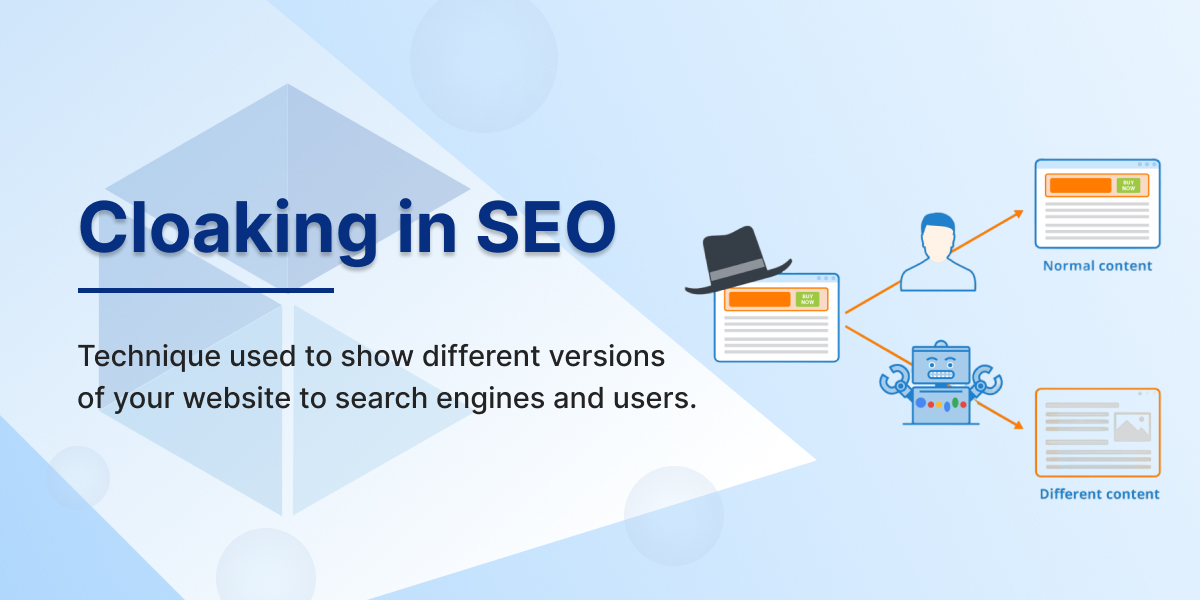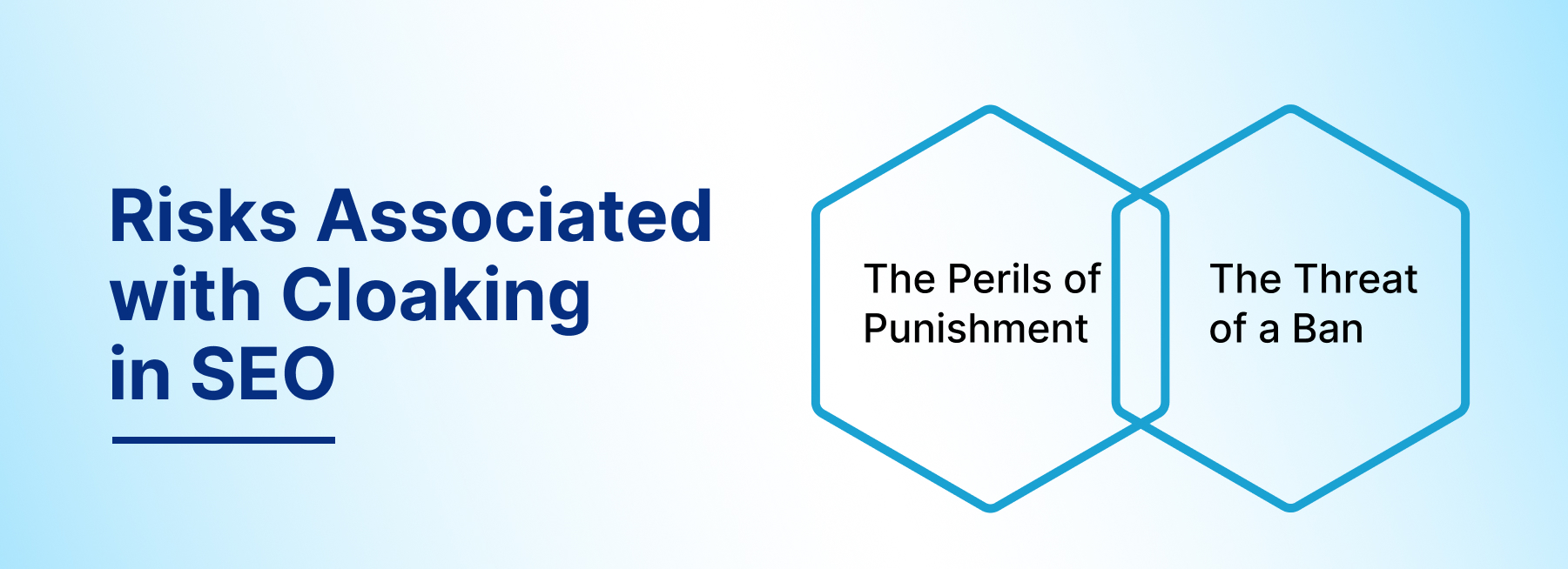
Posted On : 17 November 2023
Search Engine Optimization, or SEO, is the lifeblood of digital visibility. In an ocean of websites, your platform needs to stand out, and SEO is the beacon that guides users to your content. Essentially, SEO is a suite of strategies designed to increase a website’s chances of being found by search engines—and by extension, potential visitors.
Imagine a brilliant show hidden behind a curtain; no matter its quality, it's invisible to the audience. SEO pulls back this curtain. Being discovered by the appropriate individuals at the appropriate moment is just as important as simply being visible.
The Concept of Cloaking in SEO
Enter cloaking: a contentious SEO technique. In technical terms, cloaking is when a website displays one set of content to search engine crawlers for indexing and a different set to the actual visitors. It’s a clever trick, but one that can have dire consequences.
The goal of search engines is to show viewers the most relevant content. When they crawl a site, they expect to see the same version that a user would. Cloaking in SEO disrupts this trust, creating a discrepancy between what's indexed and what's displayed.
The Motivations Behind Using Cloaking
Why do website owners cloak? The reasons vary. Some websites may be rich in visuals but sparse in text, which traditionally doesn’t sit well with Google’s algorithms. Others might rely on Flash, a technology that's not particularly search-engine friendly. Cloaking can be a shortcut to rank such content higher without making it genuinely compliant with Google's standards.
But, as with all shortcuts, the risks are substantial. Specifically, Google has said that they view cloaking as an infringement of their policies. The pursuit of quick wins could lead to long-term losses, including penalties or even a complete ban from search results.
Dissecting Cloaking Practices
Cloaking is a black hat SEO practice that comes in several forms, each designed to game the system in different ways:
- Hidden Text: This involves placing text on a page that's invisible to the visitor but readable by search engines. For instance, text could be hidden by matching its colour to the background or through more complex methods involving JavaScript or CSS.
- User-Agent Cloaking: Here, a site determines whether the visitor is a human or a search engine crawler using a piece of code. If it’s a crawler, they’re shown a different, optimised version of the site.
- IP Cloaking: This method redirects a user to a high-ranking page, unbeknownst to them, to leverage its SEO standing.
- HTTP Accept-Language Header Checks: By examining the language headers of the user, the server decides whether to show the real site or a cloaked version.
While each method is distinct, they share a common goal: to present search engine crawlers with optimised content that doesn’t match what actual visitors see. It's a risky business that can tarnish a website's reputation and plummet its rankings once exposed.
Search engines have grown wise to these tactics, enhancing their algorithms to sniff out and penalise such practices. Therefore, it's in the best interest of website owners to adhere to white hat SEO strategies that may take longer but build sustainable, long-term success.
The Risks Associated with Cloaking in SEO

The Perils of Punishment
Cloaking in SEO is a practice that may seem tempting for quick search engine ranking gains, but is fraught with significant risks. It goes against Google's Webmaster Guidelines, and such defiance comes at a cost. If you engage in cloaking, whether knowingly or not, Google may penalise your site. This means your website could crash in search rankings overnight, erasing the hard-earned trust of your visitors and the visibility of your content.
The Threat of a Ban
More alarming is the prospect of a site being banned. Google doesn't shy away from removing websites that breach its rules from its index altogether. Such a manual penalty is a severe action, often irreversible, making your website virtually invisible to users searching online.
The Inevitability of Detection
Search engines have evolved, becoming ever more adept at identifying cloaking. Their algorithms now swiftly spot the disparity between content presented to the search engine and what is displayed to the user. Therefore, employing cloaking is akin to playing a high-stakes game where the house always wins.
The Impact of Cloaking on User Trust and Brand Reputation
User experience is the heartbeat of a successful online presence. When cloaking leads to a mismatch between user expectations and the actual content, it doesn't just sour the individual experience; it can tarnish the brand's image.
Eroding Customer Trust
Once trust is broken, it's a difficult task to rebuild it. Customers value transparency, and when a brand is caught in deceptive practices like cloaking, it signals a willingness to cut corners—a red flag for many.
Long-Term Brand Damage
Your brand's reputation is a priceless asset. Deception through cloaking can severely damage the trust you've built with your customers. Trust is the foundation of any brand, and once it’s broken, it's incredibly challenging to rebuild.
Identifying Cloaking on Your Website
It's crucial to ensure your website doesn't fall foul of cloaking, even accidentally. This is how to identify the indications:
- SERP vs Page Content: Check if the content on your site matches what appears in search engine results. Mismatches might be warning signs.
- Shady SEO Signs: Be vigilant for other black hat SEO service practices on your site, such as excessive keyword stuffing, low-quality spun content or unnatural backlinks.
- Utilise Online Tools: SEO cloaking checker tools like SiteChecker can be instrumental in identifying cloaking and ensuring that your site remains compliant.
The Importance of Compliance and Prevention
Regular Site Audits
Conduct frequent audits of your website to ensure no inadvertent cloaking occurs. This preventive measure is a cornerstone of a robust SEO strategy and protects the integrity of your site.
Be Proactive Against Hacking
A hacked website can become a victim of cloaking without the owner's knowledge. Stay ahead by securing your website against unauthorized access.
Uphold Google’s Guidelines
Google's webmaster guidelines are not just rules but a blueprint for online success. Aligning with these guidelines ensures that your SEO efforts yield sustainable results.
